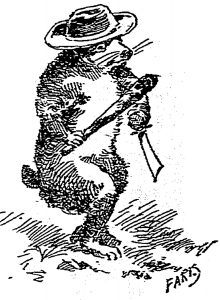Among the earliest references in Cincinnati to Groundhog Day was an announcement by John P. Ohmer, proprietor of Ohmer’s Garden in the East End. A confectioner by trade, Ohmer maintained a miniature zoo at his picnic grounds and informed The Cincinnati Enquirer on February 10, 1869 that his own personal groundhog had predicted a mild winter:
“I have a groundhog among my collection of animals in the Zoological Hall. I watched him on the 2d. He came out of his den at precisely two o’clock and has been out, more or less, every day since that time. I have been in the building every day during the winter, and had not seen him before since the 1st of October last. I have been in a business that depends on fine weather for eighteen years, and always calculated on groundhog’s day as a certain guide to go by.”

From Cincinnati Post (1897), image extracted from microfilm by Greg Hand
Although Ohmer was born in Paris, France, he based his business plan on a superstition widely attributed to Native American tribes. So did the ice harvesters of Urbana, Ohio. Before refrigeration, our ancestors kept food in the ice box—literally a box with a block of ice atop it. To have enough ice to last the year, ice harvesters needed a good, thick layer on northern lakes. The winter of 1862 had been so mild that it looked bad for the ice industry, but the groundhog came through, according to The Enquirer [February 6, 1862]:
“We have encouragement, however, from the fact, that on Sunday last, February 2, being ground-hog day, the sun shone out brightly, enabling his hogship to see his shadow, and causing him to retire to his den, which is regarded by many as a sure prognostic of hard weather for some six weeks to come.”
All indigenous poppycock, according to University of Cincinnati Professor of Botany Harris Benedict, who in 1926 told a gathering of garden clubs at the Alms Hotel: “February was called ‘month of the hunger moon’ by the Indians and many hibernating animals appeared for a new food supply during that period, among them the groundhog.”
Common Pleas Court Judge John A. Caldwell believed that country traditions such as Groundhog Day were valid only in the country, but lost their efficacy in the chaos of urban life. He told The Cincinnati Post [February 2, 1905]:
“City chaps, however, don’t put so much faith in the little animal’s prediction or in the many other ways a country man can prognosticate the weather. Who ever heard of [Cincinnati Weather Bureau Director Simon S.] Bassler looking at the trees or sniffing the breeze to find out whether it was going to rain or not? Yet people in the country can tell by the rustle of the leaves and the feel of the air when a shower is coming.”

From Cincinnati Post (1888), image extracted from microfilm by Greg Hand
Despite the dismissal of the scientific community, a variety of Groundhog Day traditions appear to predate the discovery of the North American rodent by several centuries. Groundhog Day happens to coincide with the ancient feast of Candlemas, around which many similar superstitions accrue. The Cincinnati Gazette published one of these predictions on February 3, 1866:
“If Candlemas day be clear and bright,
Then winter has taken another flight;
If Candlemas day brings clouds and rain,
Then winter is gone not to return again.”
Although Groundhog Day is rather festive, especially in little towns like Punxsutawney, Pennsylvania, Candlemas carried some distinctly macabre connotations. If we see someone’s holiday decorations still hanging in May, we might joke about the “Holiday Police,” but the old folks were dead serious about Candlemas.
Candlemas is also known in various Christian sects as Feast of the Presentation of Jesus Christ, the Feast of the Purification of the Blessed Virgin Mary, and the Feast of the Holy Encounter. It marks the canonical end of the Christmas season, and enforcement was brutal. The Enquirer reported [July 29, 1863] that all Christmas decorations must be removed from churches before Candlemas. If a single leaf or berry escaped detection, a death would ensue in the family whose pew was polluted by the festive remnant.
“An old lady (now dead) whom I knew, was so persuaded of the truth of this superstition that she would not be contented to leave the clearing of her pew to the constituted authorities, but used to send her servant on Candlemas eve to see that her own seat, at any rate, was thoroughly freed from danger.”
Apparently having dispensed with every speck of holiday glitter, the Cincinnati Business Men’s Club attempted to introduce a note of frivolity into its Ground-Hog Day observance in 1904 by offering “Ground-Hog with puree of split peas” on its luncheon menu. According to The Post [February 3, 1904]:
“One well-known business man started to leave the table, protesting that he’d never heard of ground-hog being eaten, and that it made him sick to think about it. He was reassured, however, when he was told that the ‘ground-hog’ was merely pork sausages sailing under a nom de plume.”
The Post reported [February 2, 1897] that people throughout the U.S. universally recognized Groundhog Day but were thoroughly confused how to interpret the groundhog’s shadow or lack thereof:
“In some localities the saying is that if he sees his shadow Feb. 2 he will be scared back into his hole and winter will rage for six weeks longer. Others have it that if he sees his shadow he will stay out and play with it, because spring is at hand. So it becomes a ground-hog case.”
A “groundhog case,” a phrase no longer in much use, referred to a what was also called a Hobson’s Choice—a choice that was really no choice at all.





Facebook Comments